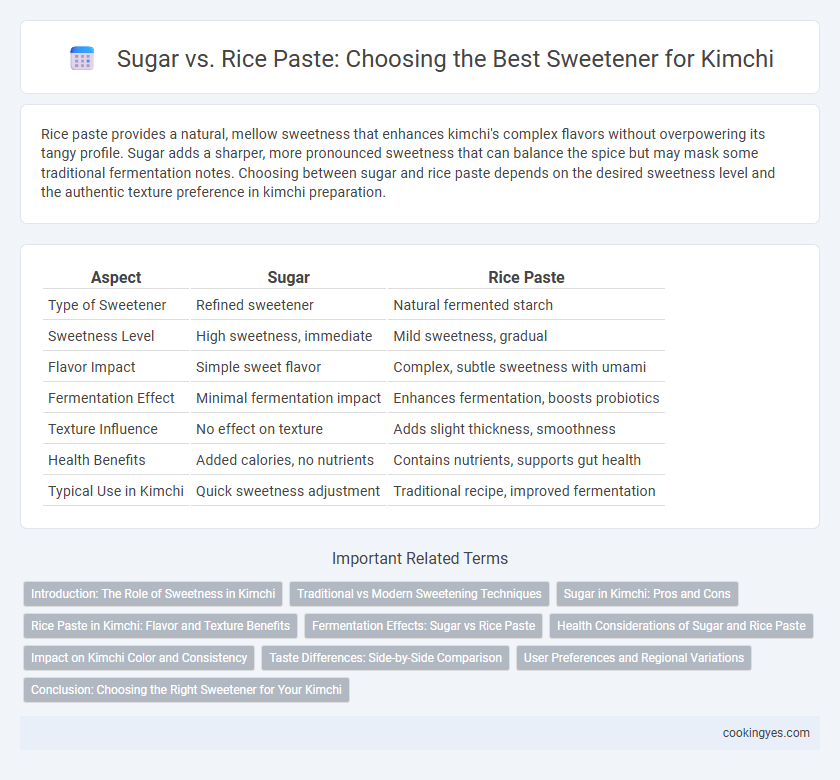Rice paste provides a natural, mellow sweetness that enhances kimchi's complex flavors without overpowering its tangy profile. Sugar adds a sharper, more pronounced sweetness that can balance the spice but may mask some traditional fermentation notes. Choosing between sugar and rice paste depends on the desired sweetness level and the authentic texture preference in kimchi preparation.
Table of Comparison
| Aspect | Sugar | Rice Paste |
|---|---|---|
| Type of Sweetener | Refined sweetener | Natural fermented starch |
| Sweetness Level | High sweetness, immediate | Mild sweetness, gradual |
| Flavor Impact | Simple sweet flavor | Complex, subtle sweetness with umami |
| Fermentation Effect | Minimal fermentation impact | Enhances fermentation, boosts probiotics |
| Texture Influence | No effect on texture | Adds slight thickness, smoothness |
| Health Benefits | Added calories, no nutrients | Contains nutrients, supports gut health |
| Typical Use in Kimchi | Quick sweetness adjustment | Traditional recipe, improved fermentation |
Introduction: The Role of Sweetness in Kimchi
Sweetness in kimchi balances the fermentation process by enhancing flavor complexity and reducing acidity, creating a more palatable taste profile. Sugar, often granulated or brown, provides immediate sweetness and accelerates fermentation by feeding lactic acid bacteria. Rice paste, a traditional sweetener, contributes a subtle, longer-lasting sweetness along with a creamy texture, promoting a smoother fermentation and richer umami depth.
Traditional vs Modern Sweetening Techniques
Traditional kimchi recipes often utilize rice paste made from fermented glutinous rice, enhancing sweetness while fostering beneficial probiotics that aid fermentation. Modern methods tend to favor sugar for convenience and immediate sweetness, although this can alter the fermentation dynamics and flavor complexity. The choice between rice paste and sugar significantly impacts kimchi's texture, taste profile, and health benefits, reflecting evolving culinary practices.
Sugar in Kimchi: Pros and Cons
Sugar in kimchi enhances fermentation speed by providing a quick energy source for lactic acid bacteria, resulting in a tangier flavor profile and more vibrant color. However, excessive sugar can lead to over-fermentation, causing kimchi to become overly soft and overly sweet, which may mask its traditional savory notes. Balancing sugar levels is crucial to maintaining optimal taste and texture while promoting beneficial microbial activity.
Rice Paste in Kimchi: Flavor and Texture Benefits
Rice paste enhances kimchi's flavor by imparting a natural, subtle sweetness that balances the spiciness and fermentation tang. It contributes a smoother, silkier texture that helps bind the seasoning evenly throughout the cabbage. The fermentation process with rice paste also promotes a deeper umami profile and improved mouthfeel compared to using sugar alone.
Fermentation Effects: Sugar vs Rice Paste
Sugar accelerates kimchi fermentation by providing readily available glucose that enhances lactic acid bacteria activity, resulting in faster sourness development. Rice paste offers complex carbohydrates that ferment more gradually, promoting a balanced flavor profile and extended fermentation stability. The choice between sugar and rice paste directly influences kimchi's texture, sweetness intensity, and fermentation rate, shaping the final taste and preservation quality.
Health Considerations of Sugar and Rice Paste
Sugar used in kimchi adds sweetness but can contribute to higher calorie content and blood sugar spikes, raising concerns for those managing diabetes or weight. Rice paste, made from fermented rice, offers a natural sweetness with added probiotics and lower glycemic impact, supporting digestive health. Choosing rice paste over sugar can enhance kimchi's nutritional profile, making it a healthier option for sweetening.
Impact on Kimchi Color and Consistency
Sugar and rice paste influence kimchi's color and consistency differently, with sugar maintaining a clearer, brighter hue while rice paste imparts a thicker, cloudier appearance. Rice paste's starch content contributes to a creamier texture and enhances the fermentation process by feeding beneficial lactic acid bacteria. Choosing rice paste results in a more opaque, velvety kimchi, whereas sugar leads to a more translucent and crisp final product.
Taste Differences: Side-by-Side Comparison
Sugar in kimchi imparts a straightforward, clean sweetness that balances the spicy and sour flavors without altering the texture significantly. Rice paste contributes a mild, natural sweetness with a subtle creamy consistency, enhancing the fermentation process and adding depth to the overall flavor profile. Taste-wise, sugar creates a sharper contrast, while rice paste offers a smoother, more integrated sweetness that complements the umami notes.
User Preferences and Regional Variations
User preferences for kimchi sweetness vary significantly between sugar and rice paste, with sugar providing a sharper, more pronounced sweetness preferred in urban areas, while rice paste offers a subtler, fermented-driven flavor favored in traditional regions like Jeolla Province. Regional variations play a crucial role, as northern parts of Korea tend to use more rice paste to balance spiciness and acidity, whereas southern regions favor sugar to enhance the overall umami profile. These distinctions reflect cultural tastes and fermentation techniques, influencing the final texture and depth of flavor in different kimchi varieties.
Conclusion: Choosing the Right Sweetener for Your Kimchi
Selecting the right sweetener for kimchi depends on the desired flavor profile and fermentation outcome. Sugar enhances sweetness quickly but may accelerate fermentation, while rice paste offers a mild, natural sweetness that promotes a balanced, longer fermentation process. For authentic Korean kimchi, rice paste is preferred to achieve depth and complexity in taste.
Sugar vs Rice Paste for Kimchi Sweetness Infographic

 cookingyes.com
cookingyes.com